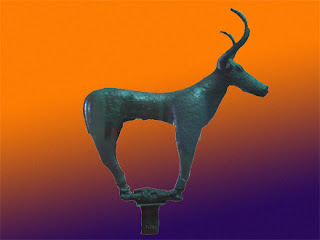Pre-Hittite Religious Standards
Some of the most important findings of Alacahöyük were the cult objects found in the royal tombs of pre-Hittite (Hatti) times from 3rd millenium BC. They are in the shape of sun discs or animals that represented gods. They are often found as grave gifts and must have been carried in funeral processions as religious standards.
Some of the most important findings of Alacahöyük were the cult objects found in the royal tombs of pre-Hittite (Hatti) times from 3rd millenium BC. They are in the shape of sun discs or animals that represented gods. They are often found as grave gifts and must have been carried in funeral processions as religious standards.
Alacahöyük Hittite Dam
It is probably one of over 10 dams that were built by Tudhaliya IV around 1240 BCE as it was written in the Hittite documents. The dam holds about 15000 cubic meters of water and was restored in 2002. The Alacahöyük village still uses it for irrigation.


------------------------------------------------------------------------------------------------------------
Alacahöyük
| AlacahöyükAlacahöyük (Alacahoyuk, Alacahuyuk) is located 36km to the north-east of the Hattusha (Bogazköy) in north central Turkey in the Çorum province. It was first excavated by Makridi Bey in 1907, but proper researches started in 1935 by the Turkish Historical Association. The excavations were made by H.Z.Koşay and R.O.Arık. Currently Prof.Dr.Aykut Çınaroğlu of Ankara University is working on the site since 1997. Alacahöyük was an important city in pre-Hittite times, but after the Hittite conquest it remained in the shadow of the nearby capital Hattuša. The most important findings of the location are the artifacts from the pre-Hittite royal tombs dating from about 2500 B.C. But most of the standing monuments are from the Hittite times. The town walls with their carved orthostats have inner and outer gateways with ramps for archers. The southern outer monumental gateway, erected by the Hittite after they reoccupied Alaca was set between two towers, guarded by two great sphinxes. In the doorjambs are 13 foot hight monoliths carved to create each seven foot high sphinx. Inside the Sphinx Gate was a large Hittite building complex that still requires excavation. The bases of the two towers by the Sphinx Gate are decorated with several orthostats. Most of the reliefs and spinxes date from 14th centurty BC. The originals are replaced with replicas at the site and moved to Anatolian Civilizations Museum in Ankara. 40°14'01 N - 34°44'46 E Google Earth location |




















































































